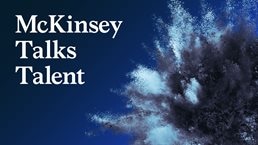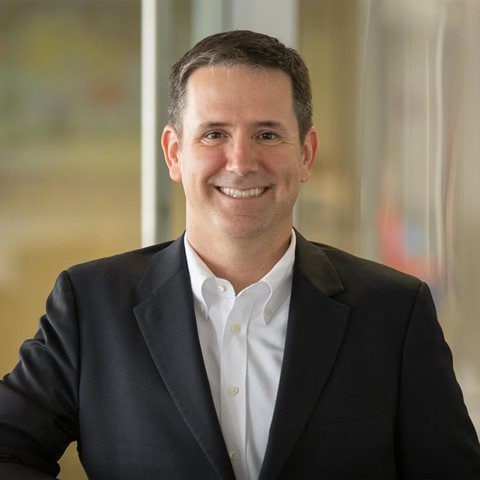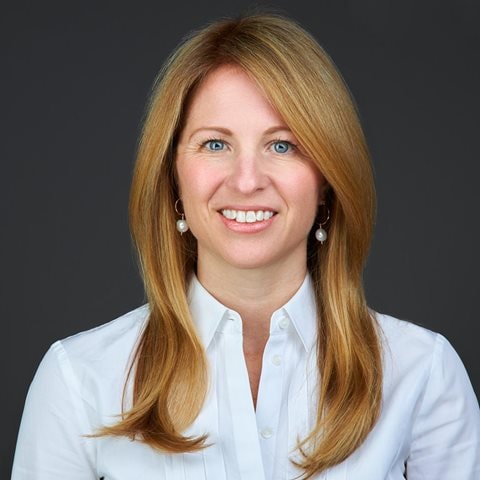The pandemic has transformed the way we work, and for many, a hybrid future is imminent. In this episode of McKinsey Talks Talent, talent experts Bryan Hancock, Bill Schaninger, and Brooke Weddle speak with McKinsey Global Publishing’s Lucia Rahilly about the need to radically rethink culture to get hybrid right—and about reckoning with the novel challenges of combining remote and on-site work. An edited version of their conversation follows.
To hear more from Bryan and Bill, subscribe to the McKinsey Talks Talent podcast on Apple Podcasts, Google Podcasts, or the audio player of your choice.
A rare opportunity
Lucia Rahilly: What do we mean when we talk about culture, and why should leaders care about it, at this stage in the pandemic?
Brooke Weddle: When we think about culture, we think about a common set of behaviors, plus the underlying mindsets that shape how people work and interact day to day. What we see in the data is compelling: companies with healthy cultures have three times greater total returns to shareholders. We’ve also looked at causation and have seen a positive relationship, where health drives performance. And vice-versa: 70 percent of transformations fail, largely due to people- and culture-related challenges. That’s a sobering number.
Lucia Rahilly: Does a strong corporate culture help companies navigate change?
Bill Schaninger: It might help, but it also might hurt. In part, culture is just a predisposition to behave a certain way. During the pandemic, there wasn’t a rule book. Previously, a lot of culture centered on getting work done. But over the past 15 months, we focused on workers first, which stressed some cultures.
Now we’re asking what a return to the workplace looks like. This is an unbelievable opportunity to remake culture. It’s rare in a leader’s lifetime to have such a clean drop for reshaping how you run the place.
This is an unbelievable opportunity to remake culture. It’s rare in a leader’s lifetime to have such a clean drop for reshaping how you run the place.
Lucia Rahilly: What are you hearing from leaders about their willingness to remake culture—and to consider a full return to the office versus hybrid?
Bryan Hancock: Some leaders are thinking about what a new culture and a new way of working might look like, and how to perpetuate culture in a primarily hybrid world. Others are saying that they need everybody back in the office to preserve their culture. And there’s some truth there; environment shapes behavior. But you can’t assume you’ll return to the same culture that existed prepandemic. There’s been too much change, both at the individual level and at the business level.
Subscribe to the McKinsey Talks Talent podcast
Rethinking culture—together
Lucia Rahilly: How does culture overlap with purpose?
Bill Schaninger: Individual purpose is something we’re seeing come to the fore. After such profound blurring in our personal and professional lives, code-switching is difficult. You’re aware that every moment you spend working is a moment you’re not spending with a child, with a parent who needs care, with your partner. Now a lot of employees are asking, “Does this job work for me? Do I care at all about what I do for a living?” Increasingly, the bar is rising, and people are saying, “My work has to be more than a job. It has to fit in with my life’s purpose.”
That creates an interesting opportunity for employers to help people figure out what really matters to them, help them find more purpose in what they do. If they can’t, maybe we help them gracefully leave. But if they can, there are obvious benefits: retention, motivation, satisfaction, engagement, productivity—all of it goes through the roof.
Lucia Rahilly: We’ve certainly seen leaders energized to talk about purpose since the onset of the pandemic. Does our research indicate that employees are focusing on purpose as well?
Brooke Weddle: We’ve found that meaningful values, as a management practice, were a core differentiator of companies that maintained a healthy culture during COVID-19. Companies were able to drive an innovation agenda when they emphasized bottom-up innovation, harnessed ideas from the front lines, and encouraged employee creativity and entrepreneurship in getting work done. We also saw healthy companies emphasizing the free flow of information—knowledge sharing, performance transparency—as well as practices like role clarity and operational discipline. Successful companies were innovating and shaping new solutions and translating them back into systems and processes.
Bill Schaninger: We also have research suggesting that as we plan for a return to the workplace, employees want to be involved and not kept in the dark.
Brooke Weddle: I’ve been working with a lot of organizations doing that kind of listening, with two speeds in mind. One is immediate: getting feedback on policies and guidelines. Do we need to adjust the use of videoconferencing versus phone calls? Do we need to think about policies to help caregivers?
The second is about shaping the future. How do we want to celebrate our new partner class in a law firm? Or create new rituals combining what we’ve learned in the pandemic? We’ve learned some virtual interactions can be special: you get a window into someone’s home, see their kids more. People appreciate that. At the same time, we probably need to bring back some in-person events that help people feel connected in different ways. Engaging employees in that dialogue is hugely important.
The office is the new off-site
Lucia Rahilly: Have we seen evidence that remote work has begun to rupture social cohesion?
Bill Schaninger: Fifteen months of remote has been a challenge and posed very real concerns, particularly for new people who’ve never had the upside of in-person culture—as well as for some longer-tenure folks who’ve started to feel burned out.
Lucia Rahilly: What other challenges might hybrid pose?
Bryan Hancock: One is information sharing. There’s been great research done on social networks and how they’ve been reinforced and weakened over the course of the pandemic. What we’ve seen is that within your immediate team, communication and connectivity have gone up. But linkages across teams have gone down significantly.
There’s been great research done on social networks … over the course of the pandemic. What we’ve seen is that within your immediate team, communication and connectivity have gone up. But linkages across teams have gone down significantly.
In a regular office, the rhythms of a workday offer lots of opportunities to collaborate outside your immediate team. This heightens the importance of managers making connections across teams because some of those connections are what’s most important for innovation and driving the future agenda.
Bill Schaninger: Teams in the past used “hoteling,” where you had no assigned desk; when you showed up, you signed up for a spot. Now some don’t want to hotel. They want to know the whole team has a place to log in. It’s an interesting step—just letting the team get together—and not all that difficult, from a reservation-system standpoint. Some organizations are getting ahead of this and are really being thoughtful about what togetherness means, vis-à-vis both work and culture.
Brooke Weddle: I’ve worked with one CEO who wants her organization to come back and be what she calls “in-office first.” But she also wants to use the office as a tool—to reenvision what the office can mean for activities like collaboration. She and her employees are redesigning their meetings, thinking through questions like, “What’s the purpose of an innovation meeting versus a strategy meeting versus an information-sharing meeting? What needs to be done in the office, and what can be done virtually?”
Suppose my team wants to work together, but I’m going back to the office Tuesdays and Thursdays and others are going back Mondays, Wednesdays, and Fridays. We’ll never have those interactions. It sounds simple—but getting to that level of granularity helps in orchestrating the best possible outcome for in-office collaboration, so that interactions can be that much more powerful and meaningful.

McKinsey Talks Talent Podcast
Bryan Hancock, Brooke Weddle, and other talent experts help you navigate a fast-changing landscape and prepare for the future of work by making talent a competitive advantage.
Bryan Hancock: Some of my clients say the office is the new off-site—the place you get together to collaborate and think forward.
Brooke Weddle: I love it. In-office interaction can be well thought out, just like an off-site. Going in for the sake of going in—I think those days are over. People understand now that we can be wildly productive—at home. We need to incentivize people to come back for a specific purpose, and to drive toward a specific outcome.
In-office interaction can be well thought out, just like an off-site. Going in for the sake of going in—I think those days are over.… We need to incentivize people to come back for a specific purpose, and to drive toward a specific outcome.
The need to lead differently
Lucia Rahilly: And what’s the leader’s role—to be always on-site or to try to model what hybrid might look like?
Brooke Weddle: To model what hybrid looks like. Reimagining culture puts new demands on leaders, but being stretched in new ways can be inspiring. Imagine a leader orchestrating—based on tasks, on interactions, on purpose—how hybrid could work. That’s a new skill that many leaders and managers may not have but might build toward in the future. And linking that back to the question of how to maximize the true value of an employee is a profound idea.
Bryan Hancock: Leaders should be purposeful and communicative about how and where they spend their time to make best use of the team. If a leader says, “Hey, I’m going to be in the office every day because I’m going to accomplish X, Y, and Z, and I expect this subset of work to be done here and this subset handled remotely”—that can be highly effective.
Lucia Rahilly: Tom Peters coined that old phrase, “management by walking around.” In a hybrid workplace, you can’t wander around gathering information.
Bryan Hancock: It’s hard. That’s where we start to see other tools come into play. I was just talking with the leader of the executive assistant pool in our office, and she said it’s difficult to get a sense of what’s going on. Previously, you could walk around, notice body language, and follow up: “Hey, let’s get a coffee. Let’s talk.” Now, even in scheduled check-ins, everybody’s prepared. It’s more formal and harder to pick up on subtler cues.
Leaders have to ask, “How else can I get that information? Should I do pulse surveys—anonymous or tracked—that show authentic feedback instead of prepared, edited feedback? Also, having leaders skilled in asking follow-up questions—that’s part of how we need to take advantage of the ability to work remotely, to attain the kinds of insights we used to gain from walking around.
Lucia Rahilly: Does the role of the office in a hybrid culture go beyond collaboration?
Bill Schaninger: Sense making. Think about location as less about control and more about an event—so when you’re in the physical space, you know being there matters. It’s not just going to a cubicle.
When I first joined McKinsey, we were growing rapidly—it was early 2000, the dot-com era—and we would go over to the Café Royal in downtown London to have our all-hands meetings. You got there and Ian Davis, then our London office manager, would be up onstage. There was a buzz. It was special. Ian could have communicated everything he wanted to say via email, but we hung on every word because it mattered. Make sure the act of being together matters.
Lucia Rahilly: What about the potential for serendipitous interactions to spark ideas? Is there a role for serendipity in a hybrid world, where the function of the office is so planned and purposeful?
Brooke Weddle: I would posit that serendipity is part of the purpose. At Stanford, my favorite class was taught by Mark Granovetter, an economic sociologist famous for the idea of the strength of weak ties: interpersonal relationships between disparate groups of people and how they help you find opportunities. There’s huge insight in that.
As we think about the purpose of the office, we should plan for carefully orchestrated interactions, as well as for interactions that are less structured. Think about building sessions that bring together different groups to try to uncover new ideas and new thinking, as well as to develop new relationships.
Reckoning with risks
Lucia Rahilly: Is there a risk with a hybrid workplace that remote workers might slide into a kind of second-class status so that a two-tier system emerges?
Bill Schaninger: We should be cautious not to create an “in” group and an “out” group—say, if being in-person means a higher likelihood of interactions with those in positions of power. Or if some colleagues are in the same room on a shared camera, it may change the dynamics for those working remotely. Video chats are something of a grand democratizer of interactions; if we shift to a hybrid model, we don’t want to hinder the gains we’ve made on inclusivity.
Lucia Rahilly: Working women have been disproportionately affected during the pandemic, and working mothers are among those most inclined toward remote work, given the flexibility it offers. Does a hybrid model threaten to make gender inequities worse?
Bill Schaninger: I think so. Likewise for people of color. Women are often expected to be responsible for their partner, for the kids, for providing caregiving for a parent, in addition to being leaders. That load, in many cases, has become insurmountable and leaves some saying that they’re done. If we were to perpetuate this in a hybrid model, it might be too much to bear.
Lucia Rahilly: How can leaders mitigate that risk?
Bryan Hancock: Be intentional about managing for it. Set norms so that people who are not in the office feel included. For example, make sure everybody in a conference room is on their own individual video screen. Update messaging app channels to reflect conversations that happened in the office. Follow up to see how remote workers are doing and what their underlying needs are.
Often, when we talk about returning to the office, we assume there’s one office where all culture and activity and linkages happen. But most companies have a headquarters plus multiple offices in other places. If organizations shift their thinking from “the” office to “an” office, and to what they’re doing to build connectivity more broadly—that small shift can help equalize the field and headquarters a bit.
Lucia Rahilly: What’s the best way to know whether the steps you’re taking are working?
Brooke Weddle: One step is listening—asking about employee sentiment. There are also performance-based indicators, which are business-specific—looking at outcomes related to time to market or productivity, for example. Broadly, every executive team should be looking at a dashboard that’s a mix of performance and health and developing clear metrics that allow them to steer toward success. That will be a multiyear journey as we come back from the pandemic.
Bryan Hancock: I would ask executives to have a clear sense of what they’re doing to create value and why they’re doing it. What’s their purpose? How does it link to individual purpose and purpose on teams? This will put them on track to move forward and give them something to measure and communicate against.
Is hybrid here to stay?
Lucia Rahilly: Last question. Do you think hybrid will become a secular trend? Or will it just help employees navigate the next phase of change in a more psychologically manageable way?
Bill Schaninger: I think it’s here to stay. Getting people to accept arriving every day at the same place, at the same time—which may mean 90 minutes in traffic when it should only take 20, and revolving their life around those work hours—I think those days are pretty much gone, particularly now that we’ve seen that work will not suffer.
That said, a successful hybrid workplace requires a more thoughtful conversation about what employees need. Many employers will realize this is relatively easy to offer and that it dramatically increases the likelihood that their employees feel well supported and are motivated and working well. It’ll be a net positive for the employee experience. But hybrid is complicated. It requires more thought, more planning.
Bryan Hancock: One reason I think hybrid is here to stay is that it’s what employees want. In a survey we did, 30 percent of employees said they’d be likely to switch jobs if they were required to be fully on-site. And more than 50 percent of respondents said they’d like to work at least partially remotely. In a world where talent is the scarcer of the two capitals—human capital being scarcer than financial capital—companies will have to adjust to what top talent wants.
Brooke Weddle: One of the silver linings from the pandemic is that we’ve brought a lot of innovation to the way we think about employees, their needs, what gives them meaning, and how that connects back to the organization. It’s exciting—despite all the difficulties and challenges we’re going through.




